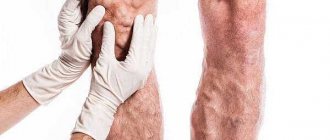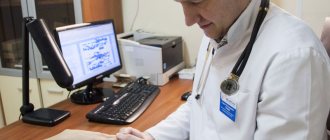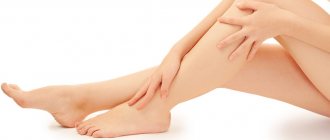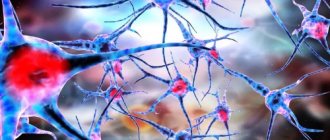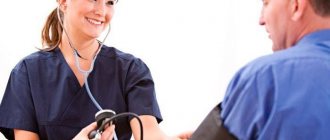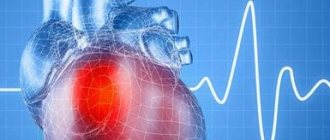When a person feels discomfort and pain symptoms in the thoracic spinal area, most often the first thought is that he is tired, has a cold, has a cold, or has “something wrong with his heart.” The spine is the last thing people think about, sometimes only after the doctor diagnoses a pathology of the musculoskeletal system. The second cause of pain, rivaling this one in frequency, is a disruption in the functioning of internal organs. There are a lot of other reasons, and it is important to recognize on your own and in time, at least at the initial stage, why your back hurts at chest level. This is necessary for timely consultation with a doctor, because in some cases pain in this area can be dangerous.
Pain in the thoracic spine
Why does the thoracic area of the back hurt?
The spine in this part consists of 12 vertebrae, which are coded with the letter T. This is the most massive and extended part of the entire spinal column. Its task is to withstand heavy mechanical loads. The difference between the upper back and the cervical area is that it is static. The vertebrae of the neck are mobile, while the thoracic vertebrae are not mobile. They are rigidly fixed to each other to avoid unauthorized shifting of the intercostal arches.
Cervical region
By the way. Not the entire section is equally immobile; the T1-T4 segment is characterized by some mobility. Further, starting from the fifth link, freedom of movement is limited to the maximum. It is for this reason that pain occurs most often at the location of the T4 vertebra, the transition from the moving part to the fixed part. This is the area between the shoulder blades, located in a direct projection to the chest.
What can cause pain in the named area, and how to classify sensations in order to understand its source.
Table. Causes of pain in the thoracic spinal area.
| Disease | Description |
| Intercostal neuralgia | Also called thoracalgia. It is a pathology that results in compression of the nerve roots in the intercostal space. Pain is felt in all conditions and intensifies with pressure on the areas of the dorso-thoracic costal spaces, precisely because of the fixation of the rib arches to the vertebrae of the sternum. |
| Pleurisy | Internal disease, pathology of the pulmonary system. When it affects the pleural lobes surrounding the lung, due to an acute or chronic pathological process. |
| Coronary pathology | One of the most dangerous causes, causing burning, intensely pulsating, tearing pain in the thoraco-dorsal region. Pathology occurs due to aortic dissection, rupture or deformation by an aneurysm. |
| Vertebral thoracic osteochondrosis or hernia | A degenerative process in the spine that affects the intervertebral discs through cracking of the fibrous ring surrounding them. |
| Scoliotic deformities | Any disease that causes poor posture causes the muscles of the chest area to tense up. This is where the deformation and the pain it causes occurs. It could also be Scheuermann-Mau disease or spondyloarthrosis. |
| Injuries and tumors | From small to spinal fracture. Cancer can also cause pain in this area. |
| Other reasons | Pathologies of internal organs. |
Neurological diseases
The most common neurological pathology is thoracic neuralgia. This disease is very common in elderly and middle-aged people. It is accompanied by severe pain, since the intercostal nerves are pinched. The reasons for the development of this disease can be:
- osteochondrosis;
- intervertebral hernia;
- inflammatory processes in tissues;
- injuries;
- malignant and benign tumors;
- significant load on the spine;
- congenital pathologies;
- stress;
- hormonal imbalance.
In addition, extra pounds, a passive lifestyle, constant overwork, and poor posture can often be the causes. The main thing that patients often complain about is chest and back pain. It is felt at the pinched site and may be aching or burning. At the same time, it intensifies with movements and sharp turns of the body. Since the intercostal nerves extend to many internal organs, innervating them, the pain radiates to the area of the heart, stomach, and scapula. Another important symptom is stiffness in the chest area. Some of the patients complain of irregular heart rhythm, breathing problems and increased blood pressure.
Intercostal neuralgia
With this diagnosis, a person experiences severe pain when being in an uncomfortable position, making sudden movements, sneezing, coughing, or simply inhaling and exhaling. The pain, once it begins, persists for a long time and practically does not go away completely, only subsiding slightly. An attack can occur both during the day and at night, even during sleep.
Intercostal neuralgia
Important. This pathology mainly affects older and elderly people; children do not suffer from intercostal neuralgia.
The pathology is related cause-and-effect to thoraco-dorsal osteochondrosis and intervertebral hernia.
Spine or heart
This disease is quite difficult to differentiate from angina pectoris. In any case, most patients mistake discomfort in the intercostal space for heart pain.
There are a number of differences between it and angina that you need to know.
- In case of cardiac pathologies, pain begins and continues during the load while it is being carried out. If you take a calm position, it hurts less. Neuralgia maintains pain even at rest.
- There are several pain points for neuralgic pain, and they can be easily felt from the back. Angina pectoris causes girdling pain in the dorso-thoracic area, which is diffuse in nature.
- Relief of angina pain occurs at rest and only neuralgic pain can be weakened by changing position.
Symptoms of an angina attack
If you want to learn in more detail how to treat osteochondrosis of the cervicothoracic region, as well as consider the symptoms and manifestations, you can read an article about this on our portal.
Treatment
The following methods are used to relieve neuralgic pain: therapy, blockade, surgery.
Pleurisy
This disease is the second common cause of pain occurring in the thoracic-vertebral region. It is into it that the pain emanating from the internal organ – the lungs – radiates. The affected petals of the pulmonary pleura become inflamed and cause pain during inhalation and exhalation, almost constant, of varying degrees of intensity.
Pleurisy
By the way. This disease can begin and develop as an independent pathology, or it can be a consequence of dysfunction of the pulmonary system due to other diseases.
The causes of effusion pleurisy include:
- tuberculosis infection;
- purulent lesion;
- injury;
- tumor formation of any quality;
- liver failure;
- hypoalbumenemia;
- heart failure;
- malabsorption;
- nephrotic syndrome.
With the pathology of this name, fluid accumulates in the lower part of the lung. Inflammation begins.
The mechanism of development of pleurisy of various etiologies
Symptoms.
- At the onset of the disease, a person, as already noted, experiences back pain in the interscapular area.
- In addition, breathing becomes difficult and quickens.
- To reduce the pain a little, the patient takes a forced position.
- A febrile state and a rise in temperature occur.
- Sweating increases.
- Shortness of breath appears.
- A dry cough begins, with virtually no sputum production.
Any of the listed signs in combination with pain should be a reason for examination. Diagnostics can, depending on the condition, be carried out on an outpatient or inpatient basis.
Symptoms of pleurisy
Important! Pleurisy cannot be caused. Untreated treatment can cause fibrous scars or fusion of the pleural area, the occurrence of pleurosclerosis and other pathologies that can only be removed surgically.
Treatment
Pain relief to help patients with pleurisy occurs through puncture. The fluid that forms at the bottom of the lung is pumped out after the puncture. As a result, the respiratory process is restored, pain goes away, and the patient feels relief.
But it is not possible to definitively cure the disease with puncture alone. After the attack is relieved, pharmacological and physiotherapeutic treatment begins, as well as breathing exercises.
Folk remedies for the treatment of pleurisy are not used due to their low effectiveness.
Preventive measures for back and chest pain
To prevent back and chest pain, you will need to follow some rules and make some lifestyle changes. The most important measures are:
- correct diet in compliance with BJU and calorie content;
- drinking regime;
- night rest on a flat mattress and anatomical pillow;
- taking vitamin complexes;
- moderate exercise daily;
- active lifestyle (running, swimming, Nordic walking, walks in the fresh air);
- correct posture while walking and working at a desk;
- proper weight lifting;
- comfortable shoes.
Preventive visits to doctors and periodic examinations are also important. In addition, you need the right psychological attitude and positive thinking. By changing your lifestyle, you can reduce the likelihood of developing diseases, including preventing pain in the sternum and back.
Coronary pathology
This reason is not the most common, but the most dangerous is when the thoracic aorta or coronary artery is dissected, torn, or otherwise damaged.
Coronary insufficiency
The patient feels sudden, very severe pain. It burns in the chest all the way to the back. Pain in the peritoneum pulsates. Hemorrhage may occur in the pleural area or chest space.
Important! If pain of a similar nature occurs, it is necessary to immediately hospitalize the patient and provide him with emergency care.
As first aid, pain relief with alkaloids is used. Then the operation is performed.
Also, chest pain projected to the back can cause a heart attack, called a posterior one. It occurs as one of the consequences of coronary artery dissection. In this case, the pain is unbearably strong, and specifically in the thoracic spinal region.
Important! Here the minutes count, and if the patient is not helped immediately, death may occur.
Video - Acute coronary insufficiency. Angina pectoris
Prevention
To ensure that chest and back pain bother you as little as possible, you must follow some rules of a healthy lifestyle:
- You need to walk and sit correctly; to do this, try to slouch less.
- Avoid lifting objects that are too heavy. Neglecting this point may result in injury and pain. If you still need to lift something, you must first bend your knees so as not to create unnecessary stress on the spinal column.
- If possible, limit your body position to a sitting position. If you work at a computer, you need to get up and stretch your muscles as often as possible. It is better for drivers to periodically stop the car and go for a walk.
- Limit consumption of salt, sweets, fatty and spicy foods. It is recommended to eat foods rich in vitamins and minerals.
- Develop healthy habits: exercise, sleep at least 6-8 hours at night, eat right. A healthy lifestyle will help you feel a surge of strength and energy, and also relieve pain.
It is worth limiting, or better yet completely eliminating, drinking alcohol and smoking. After all, toxic substances lead to degeneration of all tissues, even bone. After scientific research, it was found that alcohol-containing drinks have the ability to wash out all trace elements from bones.
Vertebral thoracic osteochondrosis or hernia
As you can see, pain in this area is not always associated with degenerative changes in the spine. But two problems with the spine directly lead to pain in the back area opposite the chest.
One of them is thoracic osteochondrosis. The second is a hernia. With these diseases of the intervertebral discs, pain in the area of the thoracic vertebrae is the main symptom. The occurrence of pain is explained by complex processes of a biological and chemical nature, as a result of which the fibrous ring is subjected to some type of destruction.
With osteochondrosis, the intervertebral foramina narrow, squeezing blood vessels and nerves, and growths of bone tissue—osteophytes—appear along the edges of the vertebrae.
This is the most common pathology among other disorders of the musculoskeletal system.
Intervertebral hernia
Three types of herniated disc
Despite their static location, the thoracic vertebrae are subject to serious stress. Due to their accumulation and age-related changes, metabolic transformations begin in articular cartilage. They weaken their strength, become thinner and lose their elasticity. The more changes the segments undergo, the more intense the pain the patient experiences.
Back and chest injuries
With many types of injuries, the back and chest hurt, this often indicates a bruise, fracture of the ribs and vertebrae, as well as the sternum, which is less common. Similar injuries occur at work, accidents, or during sports activities. In this case, mild spinal injuries cause pain of moderate intensity and spread to nearby organs and tissues, including the chest and back. In more severe cases, injuries are accompanied by loss of sensation, especially in the hands, and hypotonicity is observed in the muscle tissue. Sometimes paralysis occurs, so it is important to call an ambulance immediately after the accident, and until doctors arrive, do not touch the victim, trying to change his body position. A fracture of the sternum bone is a very rare type of injury, most often it occurs during accidents, less often during martial arts. The bone breaks when hitting the steering wheel or being impacted by a seat belt. In case of injury, the following symptoms appear:
- pain in the middle of the chest and back, which increases with deep breathing;
- swelling and hematomas;
- visible deformation in the chest area due to displacement of bone fragments.
As a rule, the body immediately reacts to mechanical damage with a variety of symptoms that require an immediate visit to the doctor.
Injuries
Varying degrees of spinal injury can cause varying degrees of pain in the thoracic vertebral area.
Spinal injury
This category includes all mechanical impacts - dislocations, bruises, concussions, fractures, impacts, displacements. They can cause damage to the spinal canal, which will ultimately lead to complete paralysis. The most serious injury is a fracture.
Compression type fractures
In case of injury, the symptoms depend on the nature of the damage, but in any case, coughing and sneezing will be painful, breathing may be difficult due to pain, and sudden movements will become impossible.
While palpating the pain points, the reaction will intensify. If injured, a bruise or swelling will be visible. Partial limitation of mobility may occur.
By the way. If the fracture occurs without damage to the spinal canal, the patient will experience pain when bending sideways, as well as the inability to raise straight legs. There will be bruising and swelling at the fracture site.
In old age, when osteoporosis occurs, the vertebral body may break due to its fragility. In this situation, inhaling and exhaling, any sideways movement, lifting even a slight weight and coughing will cause pain in the sternum, under the shoulder blade or between the shoulder blades.
Diagnosis of chest pain
If a person complains of pain in the thoracic region, the neurologist will immediately diagnose thoracalgia syndrome and begin a targeted diagnosis of the pathology that can give rise to these painful sensations. To do this, a differential diagnosis is carried out, during which the doctor excludes diseases such as:
- cardiac problems using an ECG study, if the patient has pain in the left thoracic region;
- lung diseases using fluorography, if the patient has a cough and sharp pain in the thoracic spine;
- pathologies of the esophagus and stomach using endoscopy, when the patient complains of pain in the thoracic region and stomach or acute pain in the cervicothoracic region.
In order to exclude serious abnormalities of the spine, for example: hernia, compression fractures of the vertebrae, tumor or tuberculosis of the spine, the neurologist will refer the patient for an MRI of the thoracic spine.
| Service | Price | Price | Promotion Price |
| Appointment with a therapist | primary 1800 rub. | repeat 1500 rub. | |
| Neurologist appointment | primary 1800 rub. | repeat 1500 rub. | free after MRI of the spine |
| Orthopedist appointment | primary 1800 rub. | repeat 1500 rub. | free after MRI of the joint |
| Consultation with an acupuncturist | primary 1800 rub. | repeat 1500 rub. | free after MRI of the spine |
| Vertebrologist consultation | primary 2000 rub. | repeat 1800 rub. | |
| Consultation with a chiropractor/osteopath | primary 2500 rub. |
| Service | Price according to Price | Discount | Discount |
| Plasma therapy of the spine or joint | 1 session 4000 rub. free doctor's appointment | 3 sessions 10,500 rub. free doctor's appointment | 5 sessions 17,500 rub. free doctor's appointment |
| Classic acupuncture session | 1500 rub. | ||
| Complex acupuncture session | 2000 rub. | ||
| Pressopuncture session (combination of massage and acupuncture) | 1 session 1500 rub. free doctor's appointment | 3 sessions 4200 rub. free doctor's appointment | 5 sessions 6500 rub. free doctor's appointment |
| Manual osteopathy session | 2500 rub. | ||
| Manual therapy session | 2500 rub. | ||
| Autohemotherapy | 550 rub. | 5 sessions 2500 rub. | 10 sessions 5000 rub. |
| Novocaine therapeutic blockade | 1500 rub. | ||
| Therapeutic paravertebral blockade | 1500 rub. | ||
| The blockade is therapeutic and medicinal, complex (use of several drugs) | 2000 rub. | ||
| Therapeutic intra-articular blockade with diprospan | 2500 rub. | ||
| Joint puncture with removal of synovial fluid | 2500 rub. | ||
| Intra-articular injection of hyaluronic acid (without the cost of the drug) | 2000 rub. | ||
| Novocaine therapeutic blockade | 1500 rub. | ||
| Therapeutic paravertebral blockade | 1500 rub. | ||
| Therapeutic intra-articular blockade with diprospan | 2500 rub. | ||
| Joint puncture with removal of synovial fluid | 2500 rub. | ||
| Pharmacopuncture session (drug at the discretion of the doctor) | 2500 rub. | ||
| Pharmacopuncture session (without the cost of the drug) | 2100 rub. | ||
| Electrophoresis session (without the cost of the drug) | 400 rub. | ||
| Phonophoresis session / Ultrasound therapy procedure (UT) (without the cost of the drug) | 450 rub. | ||
| Magnetic therapy session | 350 rub. | ||
| SMT therapy session (Sinusoidal modulated currents) | 450 rub. | ||
| Vitamin therapy (10 injections) | 4000 rub. free doctor's appointment | 3000 rub. free doctor's appointment | 3000 rub. free doctor's appointment |
| Injections (Vitamins B12) | 800 rub. | 800 rub. | 800 rub. |
| Intravenous administration of drugs | 450 rub. | 5 sessions 2140 rub. | 10 sessions 4050 rub. |
| Intravenous drip administration of drugs (without drugs, 1 bottle) | 800 rub. | 5 sessions 3375 rub. | 10 sessions 6750 rub. |
| Intravenous drip administration of medications (with existing clinic medications, 1 bottle) | 950 rub. | 5 sessions 4050 rub. | 10 sessions 8100 rub. |
| Intravenous drip administration of drugs (without drugs, 2 bottles) | 950 rub. | 5 sessions 4050 rub. | 10 sessions 8100 rub. |
| Intravenous drip administration of medications (with existing clinic medications, 2 bottles) | 1100 rub. | 5 sessions 4700 rub. | 10 sessions 9400 rub. |
| Subcutaneous/intradermal administration of drugs | 250 rub. | 5 sessions 1180 rub. | 10 sessions 2250 rub. |
| Intramuscular administration of drugs | 300 rub. | 5 sessions 1430 rub. | 10 sessions 2700 rub. |
Scoliotic deformities
All diseases that result in poor posture cause pain in the thoracic spinal area. This can be observed in young people, with osteoarthritis or Scheuermann-Mau disease, as well as with kyphosis, kyphoscoliosis and any form of scoliosis.
Scheuermann-Mau disease: general information
Scheuermann-Mau, kyphosis
Prices for orthopedic corsets and posture correctors
The pathology begins in the joints connecting the ribs. Their tissues become coarser, lose elasticity, and weaken their connective functions. Potassium salts are deposited on the vertebral bone, forming an osteophyte. This growth begins to pinch the nerve, compressing the intervertebral canal. A pain syndrome develops - from mild to unbearable, localized in the interscapular area.
Other reasons
These mainly include pathologies of internal organs, such as:
- herpes;
- shingles;
- polio;
- liver diseases;
- gallbladder problems;
- pancreatitis;
- diabetes;
- pancreatic problems;
- gastrointestinal pathologies;
- drops in the kidneys;
- appendicitis;
- vasculitis;
- oncology.
What to do for pain in the thoracic spinal area
You should consult a doctor if the pain is intense and does not go away. When contacting, carefully describe your symptoms. Manual diagnostics and a series of examinations will be prescribed, including MRI, cardiogram, and tests.
The primary diagnosis is carried out by a therapist. He then refers the patient to other specialists.
Primary diagnosis is carried out by a therapist
If we talk about preventive measures to prevent pain in the thoracic spinal area, they are as follows.
- Hardening.
- Cold and hot shower.
- Charge every day for at least a third of an hour.
- Lack of excess weight.
- Balance in nutrition.
- Orthopedic furniture for sleeping (mattress) and work.
- Align your back and maintain good posture.
- Lifting weights competently.
- No injuries.
- Playing sports with a trainer.
Orthopedic chair
Is it possible to help yourself with back pain opposite the sternum? There are warming compresses and ointments, exercises and decoctions. But it is best to use them after the doctor has authorized the appointment, so you will have to find a way to show up to him.
Referred pain
Referred pains are those that do not occur in the area of the diseased organ, but appear elsewhere. This often leads to misdiagnosis. Such pathologies include the following:
- bronchitis and pneumonia – pain in the front of the chest and back;
- a hypertensive crisis may be accompanied by pain near the shoulder blades;
- myocarditis and pericarditis – pain in the middle of the chest;
- myocardial infarction - burning pain in the sternum, back, as well as in the shoulder blade, arm, and shoulder on the left;
- angina pectoris - short-term chest pain, lasts no more than 10-20 minutes, radiates to the left shoulder and arm;
- ulcer of the stomach and duodenum - a sharp or aching pain that starts from the stomach and radiates to the chest and left arm;
- pancreatitis - the pain is girdling in nature and radiates to the hypochondrium.
Sometimes pain can radiate to the chest area and back with kidney disease and cholelithiasis.
